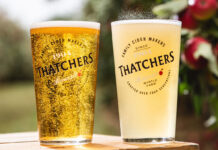Caledonian Brewery expert says only beer should be kept in the dark
ALLAN Stevenson’s job sometimes takes him far from the Scottish pub cellars he usually frequents.
He has just returned from Gibraltar where he advised publicans on keeping Caledonian Brewery’s beers at their best in warmer climes.

In his day-to-day role as Caley’s trade quality and training manager he provides advice to Scotland’s licensed trade operators.
And he said during “quality audits” of premises one of the recurring issues is the storing of foodstuffs in cellars.
“I know it’s a cold place, but trying to explain to people that they shouldn’t keep anything else in the cellar other than beer sometimes receives a shrug of the shoulders,” he told SLTN.
“I’ve found fish, potatoes, buffet meals and sandwiches lying on top of beer kegs.
“They’re going to contaminate the air and the air is going to contaminate their beer.”
Stevenson’s key aim is to help operators boost throughput and sales through well-kept beer.
He advises them on the temperature of their cellar, how to look after their beer and the safe storage of kegs.
Beer line cleaning, he says, should be carried out weekly and operators should carefully follow the instructions on “brewery approved” cleaner to ensure the product is served at its best.
One of the most important things, he insisted, is the cleanliness of the cellar. He recommended a weekly cleaning regime to maintain optimum conditions and avoid hazards.
“A cellar needs to have hot and cold running water and should also have a drain to take away the water,” he said.
“For cleaning the floor and walls, they should be using hot water and washing up liquid.
“The key thing is not to use line-cleaning fluid to clean the floor and the walls because it gives off a lot of chlorine which can contaminate the cellar.
“The cellar should be cleaned every week, I do it the day before deliveries because the cellar’s empty. It’s also good to have a cleaning record or a log book to record when cleaning was done.”
If bottled beers or other packaged stock must be kept in the cellar, Stevenson suggested licensees place them on top of a wooden pallet, which allows easier access for floor cleaning.
“If you don’t have something to lift them off the ground, the floor can get wet and it can contaminate the cellar and stock,” he said.
The ideal cellar temperature, according to Stevenson, is between 11˚C and 13˚C, which may have to be adjusted in warmer locations. This was illustrated by a recent visit overseas, when Stevenson suggested an operator increase their cellar temperature because the beer was being kept too cold.
Depending on the size of cellar, the volume of beer being delivered can often be bewildering for staff to keep tabs on.
But a good stock rotation system can help licensees to keep track of how long each keg has been in the cellar and when more should be ordered.
Stevenson suggested operators keep a log book of when a keg or a cask was delivered and keep records of when a cask was chilled, vented and tapped.
“Ideally you should have ten days worth of stock in the cellar,” he said.
“Beer takes two or three days to reach the cellar temperature.”
Mistakes, though, are still being made.
“The most common mistakes are not having the right cellar temperature, not having the right cleaning processes, or taking the feed off an empty barrel and putting it straight on to a new barrel,” said Stevenson.
In addition to providing cellar advice and quality audits as part of Caledonian Brewery’s after sales service, Stevenson advises operators on how to pour the perfect pint and maintain glassware.
He also distributes handouts, hosts brewery tours and sampling sessions when not inspecting cellars.
He added: “We want to make them into cask specialists so we want them to buy into what we do.”

























